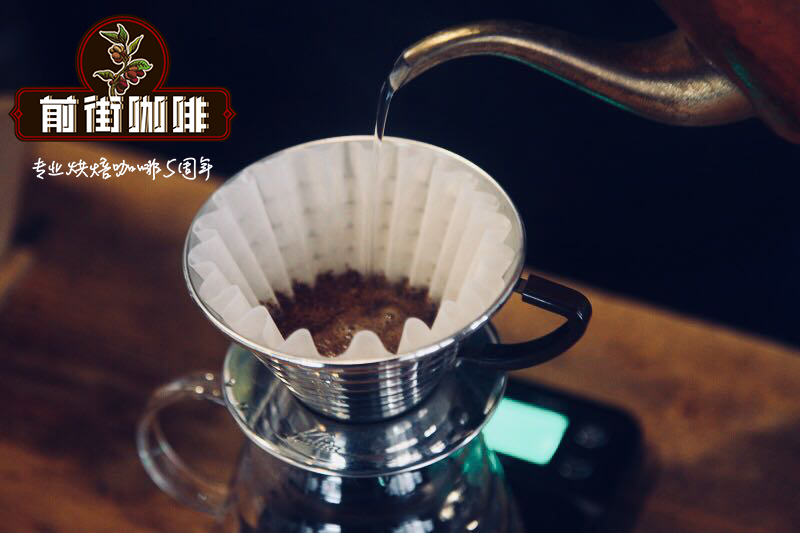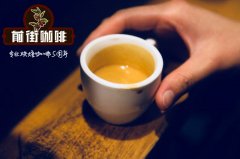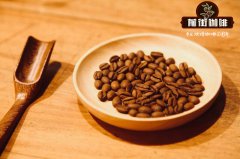How many regions and characteristics of coffee species are roughly distributed in the world?

Professional coffee knowledge exchange more coffee bean information please follow the coffee workshop (Wechat official account cafe_style)
Coffee beans can be divided into Arabica and Robusta.
Among the global coffee, Arabica accounts for about 70% of the total output, which has important commercial value. Arabica species spread to all parts of the world from the Arabian Peninsula, and subspecies such as Tibica species and slope species appeared according to the route of transmission, and then many branching varieties were produced because of mutation and mating.
Arabica species
The shape of the bean is small, the front is long oval, the middle crack is narrow and tortuous, and the arc on the back of the bean is flat.
Arabica coffee is grown in Brazil and Colombia in South America, Central America, Costa Rica in the Caribbean, Guatemala, Jamaica, Mexico and Ethiopia. Arabica coffee beans are large, uniform in size and glossy in color. Coffee beans that are generally familiar to everyone, such as Santos in Brazil, Mantenin in Sumatra, Mocha in Yemen, Blue Mountain in Jamaica, etc., are high-quality coffee beans grown in Arabica.
Arabica coffee is more difficult to grow, they like mild days and colder nights, too cold, too hot, too humid climate can be fatal to it. Coffee trees in Arabica need to be planted on sloping slopes at high altitude. they grow luxuriantly in the highlands (600,000Mel 1800m) and require special climatic conditions-an area with an average annual temperature of about 20 degrees Celsius and plenty of rainfall without frost. Only more than 50 countries in the world have such conditions, all of which are about 160 kilometers north and south of the equator. Its harvesting must be carried out manually, which is more difficult. However, due to the excellent aroma, balanced taste and low caffeine content of Arabica coffee beans, the actual planting amount accounts for about 70% of the total coffee planting.
The caffeine content of Arabica is relatively low, which is only about half of that of Robasta, so its price is higher.
Robusta species
The bean shape is larger, the front is gradually round, the back is round and convex, and the crack is straight.
The Robasta coffee tree is native to Madagascar in west-central and eastern Africa and Indonesia in Asia, and accounts for about 20% of the world's output. 30% of the world's output. Robasta coffee tree is suitable for planting in the lowlands below 500 meters above sea level, has strong adaptability to the environment, can resist bad climate, resist diseases and insect pests, and does not need much artificial care during soil preparation, weeding and pruning. It can be allowed to grow in the wild, and it is a kind of coffee tree that is easy to cultivate. But its finished product tastes more bitter than Arabica, its caffeine content is higher, and its quality is much lower, so it is mostly used to make instant (instant) coffee. Since it is mainly produced in Africa, most Africans drink robastian coffee.
Liberian species
The Liberian species, the large-grained species, is native to Liberia in Africa, as well as a few countries such as Malaysia. Its cultivation history is slightly shorter than the other two coffee trees. Liberian coffee trees are suitable for growing in lowlands. Its trunk is high and strong, with 18 Michael, large and tough leaves, and large fruits and coffee beans. Its seed coat is close to the seed kernel and is scarlet when it is mature. The quoted flavor is strong, the caffeine content is medium, the irritation is strong, and the quality is poor. Because of its unique taste, low demand and small cultivated face value, it produces less than 5% of the world's coffee production.
Esselsa species
Ethel sa is a variety discovered in 1904, which is native to the Charlie River Basin in Africa, with small fruit and high yield per plant, especially a drought-resistant variety. The product has a strong flavor, slightly bitter taste and less cultivation.
Typica: the oldest native variety in Ethiopia, all Arabica are derived from Tibica. The top leaf of Tiebika is bronzed and the bean body is oval or thin in shape; the flavor is elegant, but the physique is weak, the disease resistance is poor and the fruit yield is less. Excellent manor beans such as the Blue Mountains of Jamaica, Manning of Sumatra and Kona of Hawaii all belong to Tibika. One of the characteristics is that the top leaf of Tibica is bronzed.
Bourbon: a variant of the early (prehistoric coffee) Tibika that changed its shape from thin to round after it was transplanted to Yemen. It was named bourbon in 1715 after France transplanted round beans from Yemeni mocha to the island of Bourbon on the east coast of Africa (renamed Reunion after the French Revolution). Bourbon beans spread to Brazil and Central and South America in 1727, and the British transplanted Yemeni mochas to St. Helena Island (where Napoleon was later imprisoned) in 1732. Bourbon is the winner of the American boutique coffee cup test.
[gene mutant]
Pointed Bourbon (Bourbon Pointu): found in Bourbon Island in 1810, beans changed from round to pointed, with only half the caffeine content, but in small amounts, weak and extremely precious (mostly cultivated in the laboratory).
Elephant bean (Maragogype, or Elephant Bean): Tibica's best-known variety of beans, first discovered in 1870 in the Maragogype bean-producing region of the state of Bahia in northeastern Brazil, is at least three times larger than the average Arabica, hence the name. The taste of elephant bean is poor in low altitude area, but it has better flavor at high altitude, mild sour taste and sweet fragrance. (the right side of the picture is like beans)
Bean article _ 3616
Geisha / Geisha: a derivative of the Tibika family, it was exported from the Geisha Mountains of southern Ethiopia in 1931 (Geisha is synonymous with Japanese geisha). It was unknown in many countries and was transplanted to Panama in the 1960s and did not begin to win cup tests until 2005.
Kenyan "SL28" and "SL34": the bourbon line, screened and cultivated by French and British missionaries and researchers in Kenya in the early 20th century, has adapted to Kenya's high-concentration phosphate soil for a century, giving birth to Kenyan characteristics of sour elves; top Kenyan coffee comes from these two varieties, but it loses its flavor when transplanted elsewhere.
Yellow bourbon (Bourbon Amarello, or YellowBourbon): a bourbon variety endemic to the Brazilian state of Sao Paulo, where the coffee fruit does not turn red and is orange when ripe. It was later found that the pericarp of other local bourbon-derived varieties also turned yellow.
Kaddura (Caturra)
It is a single gene variant of bourbon found in Brazil in the 1950s. It has better yield and disease resistance than bourbon, and the tree is shorter and easy to harvest. Unfortunately, it has the same problem as bourbon-- as a result, it takes a year off for a year. The flavor is equal to or slightly worse than bourbon beans.
But it is more adaptable, can be planted with high density, does not need shade trees, and can be vibrant in direct exposure to the sun, so it is also called "exposed coffee" (Sun Coffee).
Kaddura is suitable for high altitude areas from 700m to 1700 m, but the higher the altitude is, the better the flavor is, and the bean yield is relatively reduced. There are also variants of yellow Kaddura in Central and South America, but the wind rating is not as good as Huang bourbon.
Pacas (Pacas): a bourbon variety found in El Salvador. In 1935, the Salvadoran coffee farmer "Don Alberto Pacas" selected a high-capacity San Ramon bourbon variety to be planted on a farm. In 1956, his coffee tree yielded more fruit than the same kind of coffee tree. Professor "Dr. William Cogwill" of the University of Florida identified this as a genetic mutation in bourbon and named it "Pacas".
Pacas, with its high output and good quality, is popular in Central America. Currently, 68% of El Salvador is bourbon, while Pacas has 29%.
Vera Saatchi (Villa Sarchi): the bourbon variety, first discovered in Costa Rica in the 1960s, has often appeared on the cup test list of excellence in recent years. This is a rare variety bred through the cross of red bourbon tree species. Strong wind resistance, preference for high altitude environment, excellent acidity and a variety of fruit aromas, high sweetness, bright and delicate citrus acidity and low raisin and nut aromas, high complexity and full balance.
Kona: although planted at an altitude of several hundred meters, Kona from the Big Island of Hawaii, with a mild sea breeze and rich volcanic soil, has an incomparably clean acidity and sweetness. Compared with the blue mountains with higher elevations, it is even worse.
Blue Mountain (BlueMountain): blue Mountain, which is popular all over the world and hard to get a bean, comes from the iron pickup family. Why is Blue Mountain so hot and expensive?! It is mostly because it is contracted by the royal army, and partly because it is not satisfied with soil and water and is in poor condition once it leaves Jamaica. After two hundred years of domestication, Blue Mountain has evolved successfully in Jamaica, and its resistance to fruit rot is better than that of ordinary iron pickups.
[Arabica intraspecific hybridization] (Intraspecific Hybrid)
New World (Mundo Novo): a natural cross between Bourbon and Sumatra Tibica, first found in Brazil. Because of its high yield and resistance to diseases and insect pests, it was widely planted in Brazil in the 1950s and was praised as the new hope of the Brazilian coffee industry, but the trees were tall and difficult to harvest.
Catuai: Kaduai is a hybrid of New World and Kaddura. It inherits the advantage of Kaddura's low stature and makes up for the weakness of Arabica fruit. The result is solid, and it is not easy to fall when the strong wind blows. The biggest regret is that its overall flavor is slightly more monotonous than Kadura.
Kaduai also has the difference between red fruit and yellow fruit, and red fruit wins more often than yellow fruit. Kaduai, Kaddura, New World and bourbon are the four main varieties of coffee in Brazil.
Pacamara: a hybrid between Pacas (Pacas) and elephant bean (Maragogype), with a large bean body, second only to elephant bean, is an excellent variety produced in El Salvador in the 1950s, and has achieved good results in cup test in recent years.
Kent: the Tibica hybrid found in India has high yield and strong disease resistance, but has not achieved good results in the cup test.
Hybrid between Arabica and Robbosa bean (Interspecific Hybrid)
Timor: a natural hybrid found in East Timor, an island nation at the eastern end of the Nusa Tenggara Islands, with 44 chromosomes close to Arabica, but with a mediocre flavor, low sour taste and lack of characteristics, it is often used as a low-cost formula bean in Taiwan. However, East Timor also has high-altitude pure Tibica treated with water. Before buying, it is important to find out whether it is a hybrid or a purebred iron card water washed beans, the quality of the two is very different, the former is mediocre, and the latter is amazing.
Catimor: in 1959, the Portuguese mixed Brazilian Kaddura and Timo and bred the second generation of Cartimo, which had strong disease resistance and yield capacity. But the flavor is also poor, and it is an important variety of commercial beans at present. In recent years, botanists from all over the world have turned to the interbreeding of Arabica and Katimodo belts in an attempt to reduce the pedigree of radish beans in order to improve the bad reviews of the Katimo Cup.
Icatu: a Brazilian variety that has been improved for many generations and has been in the top ten of Brazil's Outstanding Cup. In the past, Arabica mixed with turnip beans Arabusta "Arabusta", although increased yield and disease resistance, but the coffee flavor has not been good. Scientists crossed Arabica varieties with Arabica varieties such as Kaddura, New World and Bourbon for many generations, which gradually reduced the bad smell of radish beans and improved the aroma of Arabica beans, thus giving birth to an excellent variety of multi-generation hybrids-Icato.
Ruyilu 11 (Ruiru 11): a hybrid variety developed in Kenya in 1985 with heavy yield and low quality. There are no varieties of Arabica and sturdy beans that can be regarded as boutique coffee so far, so they are not available in many suppliers that specialize in freshly roasted boutique coffee, such as fresh. However, even many imported specialty coffee suppliers mix the hybrid beans with Blend to reduce costs. From the above-mentioned gene mutants (whether natural or scientific products), their flavor has a lot to do with specific geographical conditions.
END
Important Notice :
前街咖啡 FrontStreet Coffee has moved to new addredd:
FrontStreet Coffee Address: 315,Donghua East Road,GuangZhou
Tel:020 38364473
- Prev

What is the native variety? What is the grading system for Ethiopian beans?
Compared with Kenya, beans in Ethiopia are generally of different sizes and have significantly lower evenness. Whether it is Yega Xuefei or Sidamo, whether it is washing or sunlight, sometimes the same batch of coffee beans can be seen to be significantly different in baking color and particle size. Why are Ethiopian coffee beans always big and small? People who often drink Ethiopian coffee should have heard of [H]
- Next

The growing environment of coffee where can coffee be planted in a suitable coffee growing area
Professional coffee knowledge exchange more coffee bean information Please pay attention to the coffee workshop (Wechat official account cafe_style) Coffee growing reference conditions Coffee growth conditions will reflect the quality of coffee climatic conditions Arabica coffee is not resistant to high temperature and humid climate, can not be in a long-term low temperature below 5 ℃, so more planted in the steep slopes of 1000-2000 Michael land above sea level.
Related
- Beginners will see the "Coffee pull flower" guide!
- What is the difference between ice blog purified milk and ordinary milk coffee?
- Why is the Philippines the largest producer of crops in Liberia?
- For coffee extraction, should the fine powder be retained?
- How does extracted espresso fill pressed powder? How much strength does it take to press the powder?
- How to make jasmine cold extract coffee? Is the jasmine + latte good?
- Will this little toy really make the coffee taste better? How does Lily Drip affect coffee extraction?
- Will the action of slapping the filter cup also affect coffee extraction?
- What's the difference between powder-to-water ratio and powder-to-liquid ratio?
- What is the Ethiopian local species? What does it have to do with Heirloom native species?

